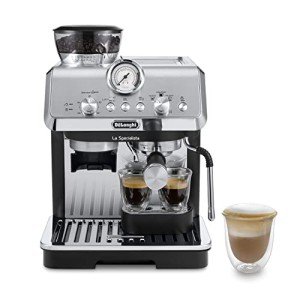The Art of Italian Espresso Machines: A Brewed Tradition
Italian espresso machines are not simply home appliances; they are an essential part of Italy's rich coffee culture, representing a blend of artistry, engineering, and style. Coffee enthusiasts around the globe recognize the significance of high-quality espresso, a staple of Italian life and food. This post checks out the history, mechanics, types, and elements to think about when buying an Italian espresso machine, showing the depth of this precious drink and its developing methods.
History of Espresso Machines
The espresso machine's evolution go back to the early 20th century in Italy, where coffee was not simply a beverage but an essential social routine. The preliminary attempts to brew espresso begun with easy, stove-top models, gradually evolving into intricate machines that could replicate the best brew.
- 1901-- The First Espresso Machine: The first steam-powered espresso machine, referred to as the "Ideale," was developed by Luigi Bezzera. Latte Machines marked a turning point in espresso developing.
- 1938-- The Lever Machine: The intro of the lever machine made it much easier to manage the pressure used in espresso extraction, boosting taste consistency.
- 1947-- The Automatic Machine: Reaching more consumers, Gaggia released the first automatic espresso machine, additional promoting espresso bars.
- 2007-- The Digital Age: Technological improvements caused the birth of totally programmable machines, allowing users to personalize their brewing settings to achieve an individualized coffee experience.
Key Features of Italian Espresso Machines
Italian espresso machines embody precision, workmanship, and development. Here are some essential components that highlight their significance:
| Feature | Description |
|---|---|
| Boiler Type | Identifies how heat is created and preserved. Single-Serve Espresso Machines consist of single boiler, dual boiler, and heat exchanger. |
| Group Heads | Where the coffee is brewed; commercial machines frequently have several group heads for efficiency. |
| Pressure Control | Essential for attaining the ideal espresso; most machines run at 9 bars of pressure. |
| Frothing Capabilities | The steam wand permits for milk frothing, necessary for drinks like cappuccino and latte. |
| Develop Quality | The products utilized (stainless steel, brass, and so on) influence resilience and heat retention. |
Kinds Of Italian Espresso Machines
Picking the ideal machine hinges on user preferences, budget, and meant use. Below are the main kinds of Italian espresso machines:
Manual Espresso Machines
- Pros: Offer complete control over the developing process, enabling for a tailored touch.
- Cons: Require skill and practice, can be labor-intensive.
Semi-Automatic Machines
- Pros: Provide a balance between automated and manual processes; users manage water circulation.
- Cons: Can have a steeper knowing curve than completely automatic machines.
Totally Automatic Machines
- Pros: Simplify the brewing process with push-button operations; perfect for newbies.
- Cons: May sacrifice some of the nuances of manual brewing.
Super-Automatic Machines
- Pros: Grind, tamp, brew, and froth immediately; convenient for busy lifestyles.
- Cons: Less control over the brewing variables, potential for a less genuine espresso experience.
Buying Guide: Factors to Consider
Selecting the perfect Italian espresso machine can be complicated, but considering the following factors can streamline the decision-making process:
- Budget: Italian espresso machines range from affordable to high-end designs, so set a budget upfront.
- Usage Frequency: Evaluate how frequently you will use the machine; everyday users might want a more long lasting alternative.
- Space: Measure your kitchen area or counter area; some machines can be big and require sufficient clearance.
- Maintenance: Consider ease of cleaning; machines with detachable parts or integrated cleaning functions may lower maintenance.
- User Skill Level: Beginners might choose fully or semi-automatic machines, while experienced baristas can handle manual machines.
- Brand name Reputation: Research brands understood for quality, such as Breville, Gaggia, and La Marzocco.
Popular Italian Espresso Machine Brands
Italian craftsmanship is renowned for producing some of the very best espresso machines worldwide. Here are top brand names worth thinking about:
- Gaggia: Known for its home espresso machines and cost.
- La Marzocco: A premium brand understood for its commercial-grade machines and innovative technology.
- Rancilio: Renowned for its durable construct and professional-quality machines appropriate for home and commercial use.
- Sage/Breville: Offers advanced functions and user-friendly designs, best for both beginners and lovers.
Frequently asked questions
What is the distinction between espresso and routine coffee?
Espresso is a concentrated coffee brewed by requiring hot water through finely-ground coffee under pressure. Steam Espresso Machines has a thicker consistency, richer flavor, and higher caffeine concentration than routine coffee.
Can I make milk-based drinks with an espresso machine?
Yes, numerous Italian espresso machines come with a steam wand to froth milk for drinks like cappuccinos, lattes, and macchiatos.
How typically should I clean my espresso machine?
Routine maintenance is vital. Generally, a comprehensive cleansing is advised every couple of weeks, while descaling ought to be done every 1 to 3 months, depending on water hardness.
What is the ideal pressure for developing espresso?
The ideal pressure for developing espresso is around 9 bars. This pressure makes sure the optimal extraction of flavors from the coffee grounds.
Are more pricey machines worth the investment?
Higher-end machines frequently make use of much better materials and technology, supplying enhanced durability and more constant outcomes. For major coffee fans, purchasing a good machine can elevate the espresso experience substantially.
Italian espresso machines are much more than mere developing devices; they are an event of a cultural tradition that has influenced coffee consumption worldwide. With different designs readily available to fit any user's needs-- ranging from novices to experienced baristas-- there is an Italian espresso machine completely suited for everyone. As you start your espresso journey, understanding the history, mechanics, and choices will enhance your experience and appreciation for this time-honored beverage. Whether you look for to recreate a coffee shop atmosphere in your home or fine-tune your brewing technique, these machines can delivering memorable cups of espresso decorated with the abundant history of Italian coffee culture.

